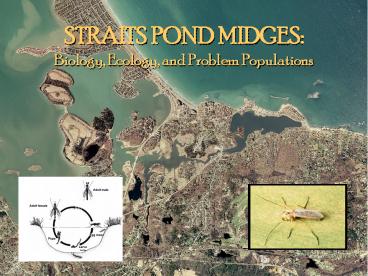STRAITS POND MIDGES: Biology, Ecology, and Problem Populations - PowerPoint PPT Presentation
Title:
STRAITS POND MIDGES: Biology, Ecology, and Problem Populations
Description:
STRAITS POND MIDGES: Biology, Ecology, and Problem Populations – PowerPoint PPT presentation
Number of Views:186
Avg rating:3.0/5.0
Title: STRAITS POND MIDGES: Biology, Ecology, and Problem Populations
1
STRAITS POND MIDGESBiology, Ecology, and
Problem Populations
2
Straits Pond inhabitants
- Anadromous/Catadromous/ Amphidromous fish
- Migratory shorebirds and waterfowl
- Invasive plants and animals
- Ailanthus altissima
- Phragmites australis
- Swans
Three-Spined Stickleback
3
Invasive plants
Tree of Heaven Ailanthus altissima
4
Invasive species
5
Straits Pond invertebrates
- Aquatic beetles
- Dragon/Damselflies
- Familiar Bluet
- Big Bluet ?
- Seaside Dragonlet
- Needhams Skimmer ?
- Periwinkle Littorina sp.
- Green Crab C. meanus
Uvarus sp.
COLEOPTERA DYTISCIDAE
6
Skimmer Dragonfly Larva ODONATA LIBELLULIDAE
7
Straits Pond invertebrates
- Flies (Diptera)
- No-see-ums (Ceratopogonidae)
- Greenheads (Tabanidae)
- Craneflies (Tipulidae)
- Midges (Chironomidae)
8
MIDGES
- Abundant and ubiquitous
- Inhabit all aquatic habitats
- Adults do not bite
- Significant food source for many other species
- Pollution-tolerant
9
(No Transcript)
10
Midge Taxonomy
- Insect order Diptera, or True Flies
- Family Chironomidae
- 20,000 species
- gt350 sub-families
- gt2,000 spp in N.A.
11
Aquatic dipteran larvae
Merritt Cummins, 1996 Aquatic Insects of N.
America
12
GENUS Chironomus
- Multivoltine - produce 1 to 4 generations each
year - Larvae are detritivores
- Larvae burrow, build U-shaped tubes
- Protection
- Respiration
- Body fluids contain high-affinity hemoglobin
C. decorus C. riparius C. plumosus C.
dorsalis gt20 spp. in N.A.
13
Chironomus life cycle
- Eggs hatch within 3 days
- Larvae live 5 - 50 days
- Temperature
- Food availability
- Depth preferences
- Overwinter in bottom sediments in mid-larval
stages
14
Chironomus larval ecology
- Associated with soft upper sediment layers
- Densities correlated with organic content
- Consume bacterial and fungal components
- Lower densities found in gravel (ponds)
- Relatively drought and freeze tolerant
- Do not migrate during dry/cold spells
15
Pupal stage
www.first-nature.com
- Brief - 2 to 5 days
- Remain in larval tube
- Float to surface before emergence
16
Pupal stage
Merritt Cummins, 1996 Aquatic Insects of N.
America
17
Adult stage
www.first-nature.com
- Adults live a few days to weeks
- Feed on nectar, or do not feed
- Females produce one batch of eggs
18
Adult stage
Merritt Cummins, 1996 Aquatic Insects of N.
America
19
Super Floss Chironomid
Courtesy of Washington Fly Fishing
Gallery www.washingtonflyfishing.com
20
Factors contributing toproblem populations
- Stagnation
- Warmer temperatures
- Lower Dissolved Oxygen concentration
- Nutrient loading
- Septic systems and fertilizers N, P, K
- Decayed algae and plants C
21
(No Transcript)
22
Problems Suggestions
- Annoying swarms gather in backyards
- Adult midges are attracted to lights
- Food is abundant
- Larvae thrive in harsh environments
- Beware of bug-zappers
- Attract more insects
- Kill beneficial spp.
- Use yellow bulbs
- Reduce nutrient sources
- Lawns/Septic systems
- Decaying plant material
- Circulate/aerate water
23
Alternative control methods
- Manual removal of detritus
- Bacterial breakdown of organic sediments
24
Alternative control methods
- Wind or solar powered water aeration
- Introduce predators
- Dragonfly larvae?
- Bream
25
Estimated percentages of aquatic invertebrate taxa
Figure 1. Freshwater streams
26
Estimated percentages of aquatic invertebrate taxa
Figure 2. Tidal ponds
27
Midge Predators
- Fish
- Feed on aquatic stages
- Most effective predators
- Waterfowl
- Feed on aquatic stages
28
Midge Predators
- Dragons and Damsels
- Consume all stages
- Charismatic
- Diving Beetles
- Voracious consumers of aquatic stages
- Tolerant, prolific
- Microorganisms
- Fungi, Bti
29
Seaside Dragonlet
Erythrodiplax berenice
30
Needhams Skimmer
Libellula needhami
31
Midge Predators
- Swallows and Swifts
- Forage on mating swarms
- Bats
- Feed in open areas
32
Looking ahead
- Monitor beneficial organisms
- Vertebrates
- Invertebrates
- Promote scientific research
- Local schools
- UMass Boston (Biology, ECOS)?
- Adapt































